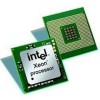Intel X5472 Specification Update - Page 27
B0-B3 Bits in DR6 May Not be Properly Cleared After Code Breakpoint
 |
UPC - 735858201551
View all Intel X5472 manuals
Add to My Manuals
Save this manual to your list of manuals |
Page 27 highlights
AX32. General Protection (#GP) Fault May Not Be Signaled on Data Segment Limit Violation above 4-G Limit Problem: In 32-bit mode, memory accesses to flat data segments (base = 00000000h) that occur above the 4G limit (0ffffffffh) may not signal a #GP fault. Implication: When such memory accesses occur in 32-bit mode, the system may not issue a #GP fault. Workaround: Software should ensure that memory accesses in 32-bit mode do not occur above the 4G limit (0ffffffffh). Status: For the steppings affected, see the Summary Tables of Changes. AX33. An Asynchronous MCE During a Far Transfer May Corrupt ESP Problem: If an asynchronous machine check occurs during an interrupt, call through gate, FAR RET or IRET and in the presence of certain internal conditions, ESP may be corrupted. Implication: If the MCE (Machine Check Exception) handler is called without a stack switch, then a triple fault will occur due to the corrupted stack pointer, resulting in a processor shutdown. If the MCE is called with a stack switch, e.g. when the CPL (Current Privilege Level) was changed or when going through an interrupt task gate, then the corrupted ESP will be saved on the new stack or in the TSS (Task State Segment), and will not be used. Workaround: Use an interrupt task gate for the machine check handler. Status: For the steppings affected, see the Summary Tables of Changes. AX34. CPUID Reports Architectural Performance Monitoring Version 2 is Supported, When Only Version 1 Capabilities are Available Problem: CPUID leaf 0Ah reports the architectural performance monitoring version that is available in EAX[7:0]. Due to this erratum CPUID reports the supported version as 2 instead of 1. Implication: Software will observe an incorrect version number in CPUID.0Ah.EAX [7:0] in comparison to which features are actually supported. Workaround: Software should use the recommended enumeration mechanism described in the Architectural Performance Monitoring section of the Intel® 64 and IA-32 Architectures Software Developer's Manual, Volume 3: System Programming Guide. Status: For the steppings affected, see the Summary Tables of Changes. AX35. B0-B3 Bits in DR6 May Not be Properly Cleared After Code Breakpoint Problem: B0-B3 bits (breakpoint conditions detect flags, bits [3:0]) in DR6 may not be properly cleared when the following sequence happens: 1. POP instruction to SS (Stack Segment) selector; 2. Next instruction is FP (Floating Point) that gets FP assist followed by code breakpoint. Implication: B0-B3 bits in DR6 may not be properly cleared. Workaround: None identified. Status: For the steppings affected, see the Summary Tables of Changes. 27 Intel® Xeon® Processor 5400 Series Specification Update















